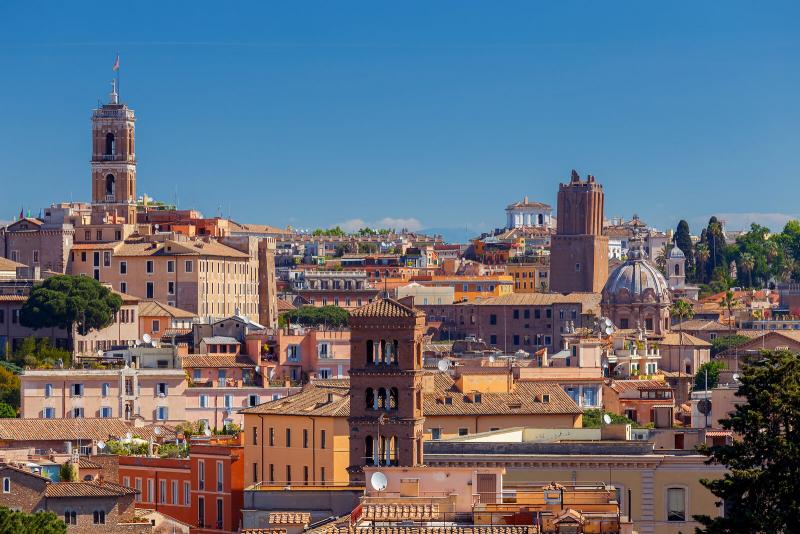The Seven Hills of Rome
ITA:

Use player to listen to Italian version
[Photo: View of Rome from the Aventine Hill.]
According to tradition, Rome was built on seven hills. To be more precise, Romulus, founder and first king of Rome, founded the city on the Palatine Hill on April 21st, 753 BCE. Originally though, Rome wasn’t known as Rome; the seven hills were occupied by small settlements independent of one another; only after they began to interact, and drain the swampy valleys between hills, replacing them with fora (public spaces outdoors), the city of Rome came into being. In the early 4th century BC, the Servian Walls were built to protect the seven hills.
The seven hills of Rome are:
- Aventine Hill: the southernmost of Rome's Seven Hills.
- Caelian Hill: during the Republican era, the Caelian Hill was a wealthy neighborhood; remains of luxury villas have been uncovered. The Basilica of Santi Giovanni e Paolo and the ancient basilica of Santo Stefano Rotondo are found on the Caelian Hill, as well as Villa Celimontana and its gardens.
- Capitoline Hill: once known as Mons Saturnius, because it was dedicated to the god Saturn, the Capitoline Hill is where Piazza del Campidoglio now stands. The piazza was designed by Michelangelo and is surrounded by medieval and Renaissance buildings which include the Capitoline Museums.
- Esquiline Hill: the Esquiline was also a fashionable residential neighborhood rising above the valley where the Colosseum would later be built.
- Palatine Hill: this is the centermost of Rome’s Seven Hills, standing above the Roman Forum, which overlooks on one side; on the other is the Circus Maximus. According to Roman mythology, the Palatine Hill is the location of the cave where the she-wolf Lupa found Romulus and Remus. Today, the hill is an archeological site which includes the Palace of Domitian.
- Quirinal Hill: to the north-east of the city center, the Quirinal Hill today is the location of the official residence of the President of the Italian Republic, the Quirinal Palace; there are other monuments on the hill, mainly built during the Baroque era; they include Piazza and Palazzo Barberini, Palazzo Colonna, the Quattro Fontane, and the church of Sant'Andrea al Quirinale, designed by Bernini.
- Viminal Hill: if you arrive in Rome by train, this is the first hill you’ll set your feet upon as it is home to the Termini Railway Station. It is the smallest of Rome’s Seven Hills, standing between the Quirinal Hill to the northwest and the Esquiline Hill to the southeast. It is also home to the Teatro dell'Opera and to the palace of Viminale, which hosts the headquarters of the Italian Ministry of the Interior.
[Foto: Vista di Roma dal colle dell'Aventino.]
Secondo la tradizione, Roma fu costruita su sette colli. Più precisamente, Romolo, fondatore e primo re di Roma, fondò la città sul Colle del Palatino il 21 aprile del 753 aC. Originariamente però, Roma non era conosciuta come Roma; i sette colli erano occupati da piccoli insediamenti indipendenti l'uno dall'altro; solo dopo che cominciarono ad interagire, e a bonificare le valli paludose tra le colline, sostituendole con mercati e piazze, nacque la città di Roma. All'inizio del IV secolo aC, le Mura Serviane furono costruite per proteggere i sette colli.
I sette colli di Roma sono:
- Aventino: il più meridionale dei sette colli di Roma.
- Celio: durante l'epoca repubblicana, il Celio era un quartiere ricco; resti di ville lussuose sono stati ritrovati. La Basilica dei Santi Giovanni e Paolo e l'antica basilica di Santo Stefano Rotondo si trovano sul Celio, così come Villa Celimontana e i suoi giardini.
- Campidoglio (o Capitolino): una volta conosciuto come Mons Saturnius, perché dedicato al dio Saturno, il Campidoglio è dove oggi si trova Piazza del Campidoglio. La piazza fu progettata da Michelangelo ed è circondata da edifici medievali e rinascimentali che includono i Musei Capitolini.
- Esquilino: anche l'Esquilino era un quartiere residenziale alla moda; sorge sopra la valle dove sarebbe stato costruito il Colosseo.
- Palatino: il più centrale dei sette colli di Roma, sorge sopra il Foro Romano, che domina da un lato; dall'altro si affaccia sul Circo Massimo. Secondo la mitologia romana, sul colle del Palatino c’era la grotta dove la Lupa trovò Romolo e Remo. Oggi il colle è un sito archeologico che comprende il Palazzo di Domiziano.
- Quirinale: a nord-est del centro città, il colle del Quirinale oggi è la sede della residenza ufficiale del Presidente della Repubblica Italiana, il Palazzo del Quirinale; tra gli altri monumenti presenti sul colle, costruiti principalmente durante l'epoca barocca, spiccano Piazza e Palazzo Barberini, Palazzo Colonna, Quattro Fontane e la chiesa di Sant'Andrea al Quirinale, progettata dal Bernini.
- Viminale: se arrivate a Roma in treno, questa è la prima collina su cui metterete i piedi perché ospita la stazione ferroviaria di Termini. È la più piccola dei sette colli di Roma, situata tra il Quirinale a nordovest e l’Esquilino a sud-est. Vi si trovano anche il Teatro dell'Opera e il Palazzo del Viminale, che ospita la sede del Ministero degli Interni italiano.











